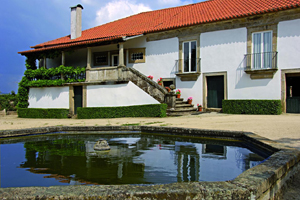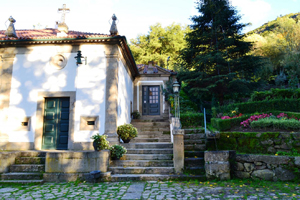
The gastronomy of Portugal is as rich and varied as its landscapes and heritage. The sea has proved to be the most defining characteristic of Portuguese cooking. Savour the simplicity of a just-caught grilled fish. How about the shellfish plucked from the waters anywhere along this coastline? An ‘Arroz de Marisco’ rice, shellfish and fish stew is always a fine choice. Let us know what you think. On the meat side, there is one true nationwide speciality: the renowned ‘Cozido à Portuguesa’ blends meat and vegetables into a richly flavoured stew. When in the north, consider a plate of ‘Tripas à la Porto,’ an Porto-style tripe dish or a variant on the bean stew ‘Feijoada’, that takes a further twist with the Transmontanan version, further inland. Good quality Portuguese olive oil is an essential ingredient to all ‘bacalhau’ dried cod recipes - and they say there are 1001 of them! In Portugal, never mind excelling in the cooking, we also know how to eat. Each dish is served with a wine certain to do good justice. And we have wines from all over the nation. While Port may steal the spotlight, the Douro and Alentejo reds, along with so many others, have gained their own just distinction. And let us not forget the cheeses! Again, the Serra da Estrela cheese takes top billing but cannot crowd out all the delicious specialities from across the Centro de Portugal and Alentejo region. Convent bakers were responsible for many of the national speciality sweets and pastries that are still able to force our eyes heavenwards. Make sure you get your hands on a ‘pastel de nata’ - our interpretation of the custard tart. They go wonderfully with coffee, particularly our bitter expresso style.
Sample the traditional flavours of the Douro region’s cuisine and wines. And finish it all off with one of its sumptuous desserts. The cuisine of the Douro region is one of the most varied in Portugal. On the coast the fish and shellfish are complemented by the region’s quality white wines. Inland, the meats, cooked in a variety of ways, are succulent and tender. Wet your appetite with port served in its freshest fashion: the ‘Portonic’. Then begin with ‘caldo verde’ soup, the most popular in Portugal. From Chaves and Lamego come the smoked sausages. Famous Douro red wines accompany pork dishes, the best known being rojões (fried pork with cumin), from the north. Another speciality is chicken rice, or dishes made with barrosã, maronesa, mirandesa and other types of beef.
The rich lands of the green north boast a strong gastronomic heritage. Enjoy some fine dining in the Minho. Caldo Verde soup - a mix of shredded cabbage, potato, garlic, onion and olive oil – is the great contribution of the Minho to national cuisine. Either as a starter or as a light meal (particularly in the early hours of the morning), try a bowl served with slices of good smoked ‘chouriço’ sausage or ‘salpicão’ jerky and corn bread. This is the land of Vinho Verde. Unique to Portugal, it is a fresh, slightly sparkling wine ideal as an aperitif. When it comes to fish, dishes based on lamprey and shad rival the cod, ‘bacalhau’, for the place of honour on the Minho’s dining table. That said however, in many ways ‘bacalhau’ grabs the limelight with recipes such as ‘à Gil Eanes’ now rightly famous. Trout ‘à minhota’ with smoked ham is another must. As for meat, a much-loved dish is ‘sarrabulho’, which begins its cooking process as boiled pig’s blood before blending with rice and much more. There are also the crackling pork ‘rojões’ and leg of pork à Clara Penha. These standard bearers all come to the fore at Christmas, the traditional time for slaughtering pigs. And make room for the local version of the ‘cozido’ meat stew; ‘Serra’ or Hill goat; and the ‘Cabra Nova’ young goat ‘caldeirada’ potato stew, traditional to Gerês.
It is important to remember that knowing Portugal through its wines and gastronomy is only one way to meet its people and share their daily life and experiences. What makes it very special is when families who have lived in these places for many generations and preserve traditions, pass on their knowledge and wisdom and receive you like one of their own.

The Casa Vilarinho de S. Romão, built during the seventeenth century and was much improved a century later. The chapel was built much earlier and was consecrated in 1462. It is distinguished by its prominent placement and harmonious architecture, which was planned to enable a balanced and enjoyable existence. Here, the charms of the past meet the comfort of the present and come together to allow for a pleasant stay in fine wine country of Douro, just a few minutes from some of region most notable landmarks.

Quinta da Mata is a house from the XVII century - with a chapel, located at 3 km from the city of Chaves in the hillside of the “Serra do Brunheiro” surrounded by a thick forest and by copious sources of water.

Visitors to Casa das Torres are greeted by a lofty gateway, which invites you into the spacious courtyard. This manor is a fine example of 18th Century architecture during the reign of King D.João V. Note the lovely Baroque details around each window. Visitors here will be treated to a splendid view of the lavish green countryside of the Alto-Minho.
This will be replaced with the Google Map.